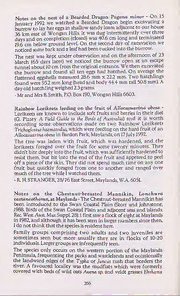
From Field and Study: Notes on the Chestnut-breasted Mannikin, Lonchura castaneothoras, at Maylands PDF
Preview From Field and Study: Notes on the Chestnut-breasted Mannikin, Lonchura castaneothoras, at Maylands
Notes on the nest of a Bearded Dragon Pogona minor - On 15 January 1992 we watched a Bearded Dragon begin excavating a burrow to lay her eggs in shallow sandy loam adjacent to our house 36 km east of Wongan Hills. It was dug intermittently over three days and on completion (closed) was 40.6 cm long and terminated 19.6 cm below ground level. On the second day of excavation we noticed some bark and a leaf had been tucked into the burrow. The nest was kept under observation and on the afternoon of 23 March (65 days later) we noticed the burrow open at an escape tunnel about 10 cm from the original entrance. We then excavated the burrow and found all ten eggs had hatched. On average the flattened eggshells measured 28.6 mm x 22.2 mm. Two hatchlings found were 95.2 mm long (head and body 44.4 mm tail 50.8 mm). A day old hatchling weighed 2.3 grams. - Mr and Mrs B. Smith. P.O. Box 190. Wongan Hills 6603. Rainbow Lorikeets feeding on the fruit of Allocasnarina obesa - Lorikeets are known to include soft fruits and berries in their diet (G. Pizzey A Field Guide to the Birds of Australia) and it is worth recording some observations made on two Rainbow Lorikeets Trichoglossus haematodus, which were feeding on the hard fruit of an Allocasuarina obesa in Bardon Park, Maylands, on 17 JuLy 1992. The tree was laden with fruit, which was hardened, and the lorikeets foraged over the fruit for some twenty minutes. They didn’t bite deeply into the fruit, which was sufficiently hardened to resist them, but bit into the end of the fruit and appeared to peel off a piece of the skin. They did not spend much time on any one fruit but quickly foraged from one to another and ranged over much of the tree while I watched them. - R. H. STRANGER, 28/76 East Street, Maylands, W.A. 6051. Notes on the Chestnut-breasted Mannikin, L onchura castaneothorax, at Maylands - The Chestnut-breasted Mannikin has been introduced to the Swan Coastal Plain (Storr and Johnstone, 1988. Birds of the Swan Coastal Plain and adjacent seas and islands. Rec. West. Aust. Mus. Suppl. 28). 1 first saw a flock of eight at Maylands in 1982, and although it has been seen in larger numbers since then, I do not think that the species is resident here. Family groups comprising two adults and two juveniles are sometimes seen but more usually they are in flocks of 10-20 individuals. Larger groups are infrequently seen. The species only occurs on the western portion of the Maylands Peninsula, frequenting the parks and wastlelands and occasionally the landward edges of the Typha or Juncus rush that borders the river. A favoured locality was the mudflats which were formerly covered with beds of wild oats Avena sp. and veldt grasses Ehrharta 266 spp. Another favoured site was the disused rubbish tip near the Police Academy, which also had beds of wild oats, and the birds utilised the Pampas Grass Cortadiera selloaria, for perching and shelter. I have seen this species feeding here on the seeds of wild oats, veldt grasses, Winter Grass Poa annua and the Barnyard Grass Echinochloa crus-galli. The birds are always very active, continually moving and feeding hurriedly, and one gets the impression that they are always hungry. Tom Delaney has observed the species in wild oats at West Belmont about two kilometres from the Maylands sites. - R. H. STRANGER, 28/76 East Street, Maylands, W.A. 6051. Red-capped Parrot feeding on leafminers - On 26 October 19901 saw a Red-capped Parrot feeding in a Flooded Gum Eucalyptus rudis on Culeenup Island, Yunderup. The foliage was heavily infested with and damaged by leafminers Perthida glyphpa. The tree had neither flowers nor seeds. For about ten minutes the parrot worked leaves through its beak to extract the larvae of the tiny moths from under the cuticle. Some of the leaves were afterwards found on the ground showing signs of that activity. Most literature cites this species as a seed-eater although te The Readers Digest Book of Australian Birds mentions the probability of insect eating. A case of Ring-necked Parrots feeding on lerp insects (Psillidae) is reported in the West. Aust. Nat. 14:76. - O. MUELLER, 7 Hamer Avenue, Wembley Downs, 6019. A Southern Fulmar (Fulmarus glacialoides) and a Blue Petrel (Halobaena caerulca) found dead on Rottnest Island - A predominantly silvery-grey, medium sized tube-nosed seabird was found on the beach at Salmon Bay near Fairbridge Bluff, Rottnest on 6 October 1991. The specimen was in fairly good condition and had been dead for only a day or two. The flesh coloured black- tipped bill with steel-blue nostrils together with white underparts suggested it to be a Southern Fulmar. The black trailing edge to the secondaries and a slight white window on the primaries strengthened the identification. Two days previously was unusually wet and windy which may have contributed to the death of the Fulmar, the second record for Rottnest. The first record (December 1954) was also on Salmon Bay, but west of my locality when a mummified beach-drifted specimen was found (E. McCrum and P. Slater 1955 West. Aust. Nat. 8:192). An almost entirely decomposed small petrel was pulled from the sand by Matthew Ryder (aged 7 years) at the eastern end of Salmon Bay on 9 October 1991. The unidentified remains were left on the beach but retrieved by Shendelle Surplice and the author the following day when it was considered that even this skeleton may have been an interesting find. It happened to be a Blue Petrel, a first 267
